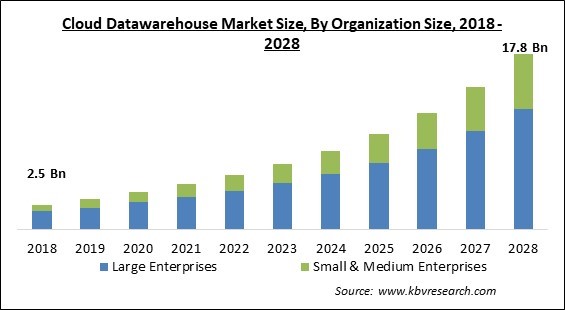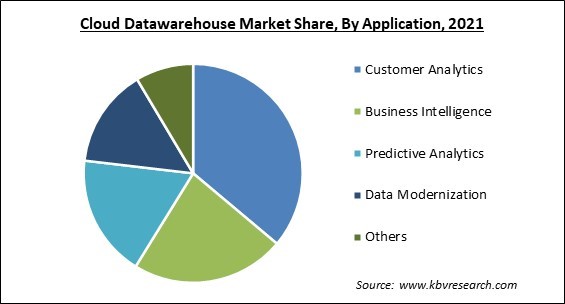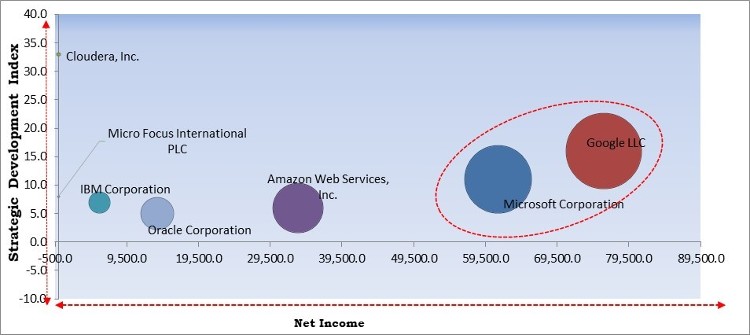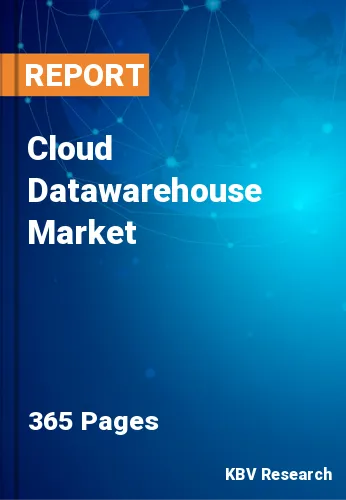The Global Cloud Datawarehouse Market size is expected to reach $17.8 billion by 2028, rising at a market growth of 21.5% CAGR during the forecast period.
The cloud data warehouse is a database that is maintained as a managed service on the public cloud and is designed for scalable business intelligence and analytics. For many years, data warehouses have been a mainstay of corporate analytics and reporting.
Companies now can flexibly build or shrink data warehouses to comply with changing company budgets and objectives due to cloud data warehousing. A cloud data warehouse is a typical data warehouse that saves data from a range of sources, including finance systems, IoT, CRM, and many others. The data saved in a cloud-based data warehouse is highly organized and standardized, making it suitable to support a wide range of particular business intelligence and analytics use cases.
Cloud-based data warehouses enable business intelligence teams to provide faster and better insights due to enhanced access, scalability, and speed, allowing them to focus on running their business instead of managing a room full of servers.
Through Data Access, an enterprise can store data on the cloud, it provides real-time data from a variety of sources to their analysts, allowing them to perform better analyses more quickly. The Scalability is growing a cloud data warehouse, which is faster and less expensive than scaling an on-premise system because it eliminates the requirement of purchasing new hardware, and scaling can be done automatically as needed. Performance allows queries addressed faster and at a lesser cost in a cloud data warehouse than they can in a typical on-premises data warehouse.
Cloud Data Warehouses offer enhanced performance, service resilience, and other benefits to clients, boosting overall industry demand for Cloud Data Warehouse. With the increased adoption of IoT technologies and the rising usage of cloud Data warehouses for processing in different businesses for various purposes, the Cloud Data Warehouse Market is expected to grow.
IoT data is complicated, with several clients and many queries, storage built in both SQL and NoSQL and transactions that must be managed by IoT apps. The data is secure and reliable due to the Cloud Data Warehouse. Additionally, Cloud Data Warehouse provides clients with information storage, automatic data backups, and replication, accelerating the usage of Data Warehouse as a Service.
The rising significance of data analytics and business intelligence in enterprise management, along with the growing reliance on data-driven decision to boost business performance and the need for regulatory oversight and security, are likely to propel the market forward.

COVID-19 has wreaked havoc on the world's economic sectors and industries. The disruptions are largely due to lockdown measures created and implemented by countries across the world as a health strategy to minimize the impact of the pandemic's spread on the worldwide population. The pandemic has boosted the market for Cloud Datawarehouses. Organizations are experiencing new challenges as a result of the COVID-19 pandemic and the rise of remote work environments. The recent economic downfall in response to the worldwide diffusion of COVID-19 highlights the necessity for alternative business methods.
With the current IT infrastructure's pace along with the fast volume of data and complexity levels, companies are focusing on strategies to emphasize business operations rather than IT infrastructure. Advances in cloud-based architecture are pushing businesses to move their mission-critical operations to the cloud, including the use of cloud-based data stores and data warehouses. The increasing adoption of IoT-enabled devices is one of the primary drivers leading development in the cloud data warehouse industry. The increased use of IoT-connected devices across the world has resulted in massive amounts of data being generated.
Cloud data warehouses are becoming increasingly popular due to their low cost. On-premises data warehouses necessitate high-cost technology, lengthy upgrades, maintenance costs, and outage management. Growing a business intelligence programme increases expenses considerably because on-premises computation and storage cannot be acquired separately. Organizations with on-premises data warehouses, for example, invest a large amount of money to accommodate data influxes in advance of major events such as a new release or the upcoming years. Data warehouse teams can buy as little or as much computing power and storage as they need using cloud data warehouses. Furthermore, cloud data warehouses do not necessitate server rooms, networking, or any additional infrastructure.
While working with data warehouses, it's critical to define the framework of access control. In most circumstances, companies are unable to determine which departments and users require data warehouse access. When users are not balanced and permissions are not granted, the system becomes overburdened, resulting in delays that cannot be avoided. A major lack of appropriate access control and sensitive information might be obtained by unauthorized people, resulting in a significant loss of corporate growth. As a result, the installation of data warehouses requires a well-defined access control mechanism.

Based on Type, the market is segmented into Enterprise DWaaS and Operational Data Storage. The operational data storage segment registered a significant revenue share in the Cloud Datawarehouse Market in 2021. The level of real data tracking and data is primarily responsible for the increase. ODS supports an organization's existing data architecture while also supporting the organization's current and future demands. Moreover, the increasing usage of artificial intelligence (AI) in data stores is expected to generate future growth potentials for the ODS industry. Companies in the Cloud Datawarehouse market offer cutting-edge solutions to keep up with the rapid development of data quantities while also adhering to regulatory compliance requirements.
Based on Application, the market is segmented into Customer Analytics, Business Intelligence, Predictive Analytics, Data Modernization, and Others. The Customer Analytics segment acquired the highest revenue share in the Cloud Datawarehouse Market in 2021. Companies establish a cleaner, more accurate image of what actions need to be made inside their business by storing all data within a CDW and attaching analytics and BI tools directly to it. A CDW removes the need for product and development marketing teams to explore different data repositories in order to uncover useful information. This centralized source ensures data integrity and provides a more actionable picture of all client data coming in from diverse sources. Organizations would need to acquire data in a variety of methods to gain the most comprehensive picture of each consumer contact. The CDW is becoming the gateway, a single point of truth where structured data would be accessed. When the similar data is stored in several places, it opens up the possibility of mistakes in the data that various teams use to make choices.
Based on Deployment Model, the market is segmented into Public and Private. The private segment recorded a substantial revenue share in the Cloud Datawarehouse Market in 2021. The Cloud data Warehouse Private Cloud solution allows teams of industry experts to self-serve the building of autonomous data warehouses marts without the expense of bare-metal installations. All data is kept in Hadoop Distributed File System in the Cloud data Warehouse Private Cloud service's base cluster which boost the growth of the Cloud datawarehouse market in the private sector.
Based on Organization Size, the market is segmented into Large Enterprises and Small & Medium Enterprises. The Large enterprise segment garnered the largest revenue share in the Cloud Datawarehouse Market in 2021. Large organizations are increasingly adopting personal cloud Data Warehouses built on No SQL-enabled storage, which provides security as well as other benefits like decreased infrastructure deployment and administrative overheads. Enterprises can develop cloud-based apps and solutions using cloud virtualization technologies, tools, and data warehouses.
Based on Vertical, the market is segmented into BFSI, IT & Telecom, Retail & E-commerce, Government, Healthcare & Life Sciences, Manufacturing, Media & Entertainment, Energy & Utilities, and Others. Healthcare and life sciences registered the substantial revenue share in the Cloud Datawarehouse Market in 2021. Healthcare and life sciences are one of the quickest verticals, due to the industry's rapid development and technological breakthroughs, which are strengthening the whole industry vertical. The importance of information quality and the need for high-grade medical administrations has grown in recent years. The usage of Cloud Datawarehouse solutions in the healthcare sector was initially gradual due to data complexity and a variety of medical and clinical data.However, the increased use of Cloud Datawarehouse solutions in recent years has proven to be beneficial in administrative and clinical settings. The massive volumes of data acquired throughout the years have been put to several uses, ranging from improving patient health to testing medications.
| Report Attribute | Details |
|---|---|
| Market size value in 2021 | USD 4.6 Billion |
| Market size forecast in 2028 | USD 17.8 Billion |
| Base Year | 2021 |
| Historical Period | 2018 to 2020 |
| Forecast Period | 2022 to 2028 |
| Revenue Growth Rate | CAGR of 21.5% from 2022 to 2028 |
| Number of Pages | 365 |
| Number of Tables | 583 |
| Report coverage | Market Trends, Revenue Estimation and Forecast, Segmentation Analysis, Regional and Country Breakdown, Competitive Landscape, Companies Strategic Developments, Company Profiling |
| Segments covered | Type, Deployment Model, Organization Size, Application, Vertical, Region |
| Country scope | US, Canada, Mexico, Germany, UK, France, Russia, Spain, Italy, China, Japan, India, South Korea, Singapore, Malaysia, Brazil, Argentina, UAE, Saudi Arabia, South Africa, Nigeria |
| Growth Drivers |
|
| Restraints |
|
Based on Regions, the market is segmented into North America, Europe, Asia Pacific, and Latin America, Middle East & Africa. North America registered the highest revenue share in the Cloud Datawarehouse Market in 2021. A significant number of people have shifted to remote employment. In addition, Canada's industries have been majorly benefitted from digitalization. While the evidence does not prove a causal link, it does show that digitalization is linked to increased labor productivity growth.
Free Valuable Insights: Global Cloud Datawarehouse Market size to reach USD 17.8 Billion by 2028

The major strategies followed by the market participants are Partnerships. Based on the Analysis presented in the Cardinal matrix; Microsoft Corporation and Google LLC are the forerunners in the Cloud Datawarehouse Market. Companies such as Amazon Web Services, Inc., Oracle Corporation, and IBM Corporation are some of the key innovators in the Market.
The market research report covers the analysis of key stake holders of the market. Key companies profiled in the report include Amazon Web Services, Inc., IBM Corporation, Microsoft Corporation, Google LLC, Oracle Corporation, SAP SE, Micro Focus International PLC, Teradata Corporation, Cloudera, Inc., and Snowflake, Inc.
By Type
By Application
By Deployment Model
By Organization Size
By Vertical
By Geography
The cloud datawarehouse market size is projected to reach USD 17.8 billion by 2028.
Low cost and more secure cloud data warehouse are increasing are driving the market in coming years, however, access control and experience of the cloud data warehouse are insufficient growth of the market.
Amazon Web Services, Inc., IBM Corporation, Microsoft Corporation, Google LLC, Oracle Corporation, SAP SE, Micro Focus International PLC, Teradata Corporation, Cloudera, Inc., and Snowflake, Inc.
The Enterprise DWaaS segment acquired maximum revenue share in the Global Cloud Datawarehouse Market by Type in 2021; thereby, achieving a market value of $11.5 billion by 2028.
The Public segment is leading the Global Cloud Datawarehouse Market by Deployment Model in 2021, thereby, achieving a market value of $13.1 billion by 2028.
The North America is the fastest growing region in the Global Cloud Datawarehouse Market by Region in 2021, and would continue to be a dominant market till 2028.
Our team of dedicated experts can provide you with attractive expansion opportunities for your business.

